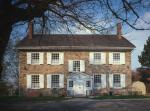![header=[Marker Text] body=[Washington's headquarters in December, 1776, before Trenton campaign. Sometimes called the Barclay House. Robert Morris and George Clymer were among its owners. At Legion Ave. and Clymer St., next to the high school. ] sign](http://explorepahistory.com/kora/files/1/10/1-A-E2-139-ExplorePAHistory-a0a4b5-a_450.gif)
Mouse over for marker text
Name:
Summerseat
Region:
Philadelphia and its Countryside/Lehigh Valley
County:
Bucks
Marker Location:
At site, Legion Ave., near Hillcrest Ave., Morrisville
Dedication Date:
January 27, 1949
Behind the Marker
General George Washington used "Mr. Berkely's Summer Seat" as his field headquarters for about a week, from Sunday, December 8, to Saturday December 14, 1776. The Continental Army was in retreat after its defeat in northern New Jersey and, after hastily fleeing the city of Philadelphia, the Continental Congress was in full flight to Baltimore. It was a chaotic period, arguably one of the darkest of the war for the patriots.
Washington's ability to regroup his troops during this period and prepare for a surprise post-Christmas crossing of the Delaware River to attack British forces demonstrates his talents as a military strategist and leader. From Summerseat, he removed to a farm near Newtown (Bucks County), in order, he claimed, "to be with the main Body of my small Army." Less than two weeks later, Washington and his poorly clothed, underfed forces surprised and defeated the Hessian mercenaries at Trenton, dramatically reviving American morale.
In 1781, near the end of the war, General Anthony Wayne conducted a secret military tribunal at Summerseat. Two British spies were tried for encouraging mutiny among Pennsylvania soldiers in the Continental Army. They were found guilty and executed.
General Anthony Wayne conducted a secret military tribunal at Summerseat. Two British spies were tried for encouraging mutiny among Pennsylvania soldiers in the Continental Army. They were found guilty and executed.
An Englishman named John Wood first settled the area that became Summerseat in 1678. Adam Hoops then purchased the land sometime in the 1760s and built the original residence. His son-in-law Thomas Barclay came into possession of the property in 1773 and erected the mansion that still stands, with some additions, today. Barclay, a prominent merchant who subsequently served as a diplomat for the new nation, owned the home during Washington's weeklong stay in 1776.
By the 1790s, however, Barclay was bankrupt and lost the property to creditors. Robert Morris, a signer of the Declaration of Independence, who had gained fame as "Financier of the Revolution," then came into possession of the home. Yet Morris, one of Pennsylvania's first U.S. Senators (1789-1795), suffered his own financial reversals and entered debtor's prison in 1798. Ownership of the house passed into the hands of
Robert Morris, a signer of the Declaration of Independence, who had gained fame as "Financier of the Revolution," then came into possession of the home. Yet Morris, one of Pennsylvania's first U.S. Senators (1789-1795), suffered his own financial reversals and entered debtor's prison in 1798. Ownership of the house passed into the hands of  George Clymer, a merchant who had also signed the Declaration. He died there in 1813. Summerseat is consequently the only home owned separately by two signers of the Declaration.
George Clymer, a merchant who had also signed the Declaration. He died there in 1813. Summerseat is consequently the only home owned separately by two signers of the Declaration.
Washington's ability to regroup his troops during this period and prepare for a surprise post-Christmas crossing of the Delaware River to attack British forces demonstrates his talents as a military strategist and leader. From Summerseat, he removed to a farm near Newtown (Bucks County), in order, he claimed, "to be with the main Body of my small Army." Less than two weeks later, Washington and his poorly clothed, underfed forces surprised and defeated the Hessian mercenaries at Trenton, dramatically reviving American morale.
In 1781, near the end of the war,
An Englishman named John Wood first settled the area that became Summerseat in 1678. Adam Hoops then purchased the land sometime in the 1760s and built the original residence. His son-in-law Thomas Barclay came into possession of the property in 1773 and erected the mansion that still stands, with some additions, today. Barclay, a prominent merchant who subsequently served as a diplomat for the new nation, owned the home during Washington's weeklong stay in 1776.
By the 1790s, however, Barclay was bankrupt and lost the property to creditors.





